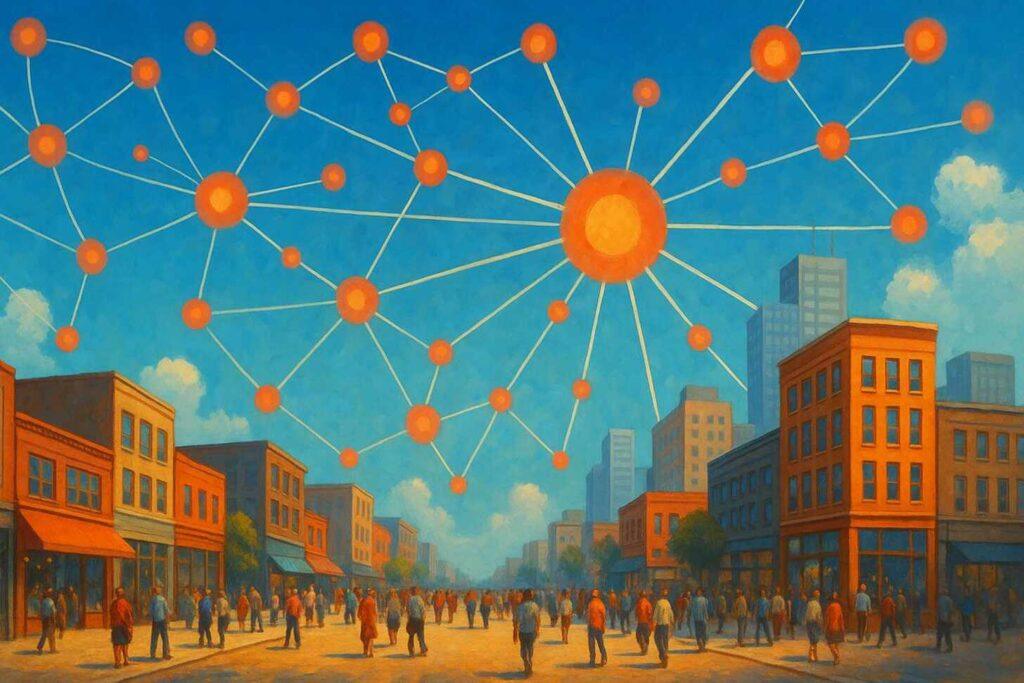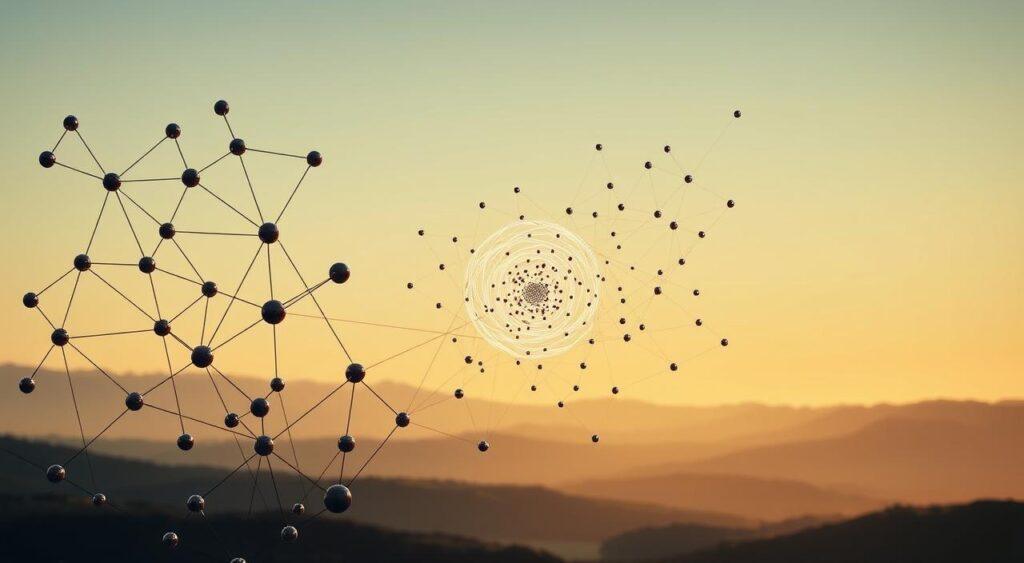Ever wonder why TikTok stars gain followers faster once they’re popular? Or why certain apps dominate their markets? The preferential attachment mental model explains this “rich-get-richer” pattern in our connected world.
It’s a simple yet powerful way to understand how networks—like social media, business partnerships, or even highway systems—grow over time.
Think of this framework as a rulebook for predicting success. Early advantages matter. A YouTube channel with 1 million subscribers attracts new viewers quicker than one with 100. Why? Existing connections act like magnets for fresh opportunities. This isn’t luck—it’s math.
But here’s the twist: you can use this knowledge. Whether building a brand, launching a product, or growing your LinkedIn network, understanding these mechanisms and the information in this model helps you make smarter choices.
Key Takeaways
- Explains why popular nodes in networks attract more connections
- Applies to social media, business growth, and idea spread
- Early advantages often lead to long-term success
- The preferential attachment mental model helps predict trends in technology and culture
- Offers strategies for personal and professional growth
Preferential Attachment Mental Model Intro
Ever notice how top apps keep growing while others fade? It’s not magic—it’s math. Networks naturally favor what’s already connected. The more links something has, the faster it attracts new ones.
This pattern, rooted in the preferential attachment mental model, shapes everything from viral tweets to highway traffic flow. Understanding these ways to leverage data can be a powerful strategy for growth.
How Connections Multiply
Imagine two coffee shops. One has a line out the door; the other’s empty. Which would you choose? Most pick the busy spot. This same logic drives digital networks. Early advantages create self-reinforcing cycles—what starts small can snowball fast.
| Network Type | Key Nodes | Growth Pattern |
|---|---|---|
| Social Media | Influencers | Follower counts accelerate |
| Websites | Popular domains | Backlinks multiply |
| Research | Cited papers | New citations cluster |
Today’s Digital Playground
Think of your favorite app. Its success likely followed this hidden rule. New users join because other people already use it.
Features improve because data flows to active networks, a part of the preferential attachment mental model. This process creates winners in tech, culture, and marketing strategy ideas.
Charlie Munger’s “latticework of theory” helps us spot these patterns. When you see connections forming, you can predict where they’ll grow next, as described in various articles on network models. Want to ride the wave instead of watching from shore?
Historical Context and Key Studies

What if I told you a 1999 research paper changed how we understand success in science? The Barabási-Albert study cracked the code behind why some ideas spread like wildfire while others fade. Their analysis of 300,000+ papers revealed a striking pattern: just 2% of studies received half of all citations.
Barabási-Albert Study Insights
The numbers told a clear story. Popular papers attracted citations like magnets, following a precise mathematical rule (k⁻³). Think of it like a busy café—once a few people cluster around a table, others join instinctively. In research, groundbreaking models become reference points that later studies naturally build upon.
This wasn’t just academic curiosity. The team showed how existing connections shape future growth in real world networks. Their work proved that citation patterns aren’t random—they follow predictable rules anyone can analyze.
Empirical Evidence of Preferential Attachment From Scientific Citations
Follow-up studies confirmed these results across fields. In biology, landmark DNA papers became citation hubs. Physics research clustered around key theories. Each case showed the same truth: early recognition creates lasting advantages.
But here’s the twist—not all networks play by these rules. Recent data reveals exceptions where new ideas can break through. This makes the models even more valuable, helping us predict when traditional patterns hold and when innovation might disrupt them.
Want an example? Consider how COVID-19 research exploded. Early vaccine studies became citation giants, yet niche treatments still found their audience. The science community’s behavior mirrored what Barabási saw decades earlier—just with better data tools.
Mechanics of Network Evolution

Picture a bustling city where popular districts attract more shops and visitors each year. Networks grow the same way—connected hubs pull in new links faster than lonely outposts.
This isn’t random chance. It’s baked into how marketing systems evolve, from internet routers to friend groups, as shown in various models and analysis found in this article.
Understanding Power-Law Degree Distribution
Ever notice how a few highways handle most traffic while side roads stay quiet? That’s power-law distribution in action. In networks:
- 20% of nodes hold 80% of connections
- Highly linked hubs form naturally
- New links favor existing heavyweights
Studies show degree distribution slopes average -2.097. Betweenness scores? A gentler -1.609. Translation: connection quantity matters more than bridging potential in growth patterns, illustrating a fundamental principle of network dynamics.
This model highlights how marketing decisions influence sales outcomes based on the nature of connections within the network.
| Network Feature | Slope | Real-World Impact |
|---|---|---|
| Node Degree | -2.097 | Creates clear leaders |
| Betweenness | -1.609 | Allows niche connectors |
Dynamics of Node Connections
Imagine two food trucks. One has a crowd—you assume it’s better. Your choice fuels its growth, illustrating the value of social proof in network dynamics.
Networks work similarly. Each new link makes a node more visible, creating self-fueling cycles.
This mechanism explains why:
- Early YouTube channels dominate
- Top-reviewed products outsell rivals
- Trending hashtags multiply followers
The process isn’t fair—but it’s predictable. By understanding these rules and the order of connections, you can position ideas where networks naturally amplify them, enhancing your article’s impact in various cases.
Evidence in Social Media and Web Networks

Ever scroll through Twitter and wonder why big accounts keep growing? The answer hides in plain sight. Social media platforms and web ecosystems follow predictable growth patterns that reward existing popularity.
Preferential Attachment Mental Model: Twitter Follower Trends
In 2014, Twitter’s data revealed a jaw-dropping pattern. The top 1% of users gained over half of all new followers. Why? Once an account hits critical mass, the platform’s design pushes it further. Retweets amplify reach, while follower counts act like neon signs saying “This account matters.”
Hyperlink Targeting Patterns
The early web showed similar dynamics. A 2000 study found 80% of hyperlinks pointed to just 20% of pages. Popular sites became reference hubs, while new content struggled for attention. Today’s algorithms magnify this effect – YouTube recommends videos others watch, and Google ranks established domains higher.
| Network | Key Statistic | Real-World Impact |
|---|---|---|
| Twitter (2014) | 1% users got 50% followers | Influencers gain disproportionate reach |
| Early Web (2000) | 80% links to 20% pages | Established sites dominate search |
What does this mean for regular users? Building a network early matters. That first 100 followers on Instagram? They’re your launchpad. Every share and tag feeds the growth machine algorithms love.
Pro tip: Collaborate with smaller creators first. Their engaged audiences can help you bypass the “rich get richer” trap. Remember, even mega-influencers started with zero followers.
Influence in Science, Media, and Society
Why do some academics become household names while others with equal talent stay unknown? The answer lies in how influence flows through communities.
Like water finding the fastest path downhill, attention naturally pools around existing hubs of activity, much like a well-crafted article that highlights key models of influence. This step in understanding the art of visibility can significantly impact the state of academic sales and the end results of research efforts.
Analysis of Citation Concentration
In academic circles, citations act like social currency. A study of 1,589 researchers revealed striking patterns: the top 5% of co-authorship links held 27.4% of total collaboration weight. Think of it like a concert crowd – everyone wants to stand near the stage.
| Network Feature | Impact Ratio | Real-World Effect |
|---|---|---|
| Betweenness | 2.5-9x | Gatekeepers control flow |
| Node Degree | Lower impact | Popularity ≠ control |
This explains why mid-career scientists often cite established names. It’s not about quality alone – visibility drives visibility. The first paper on a hot topic becomes the reference point others cluster around.
Online Patterns of Content Influence
Digital spaces work similarly. On Reddit, 78% of upvotes go to posts already trending. YouTube’s algorithm favors videos with early engagement. Why? Data flows where activity exists.
Consider two blog posts about climate change. One gets shared by a mid-sized newsletter. The other doesn’t. Within days, the first dominates search results – not because it’s better, but because communities amplified it first.
This pattern affects how we access information. Next time you research a topic, ask: “Am I seeing the best content, or just the most connected?” The answer might surprise you.
Success Through The Preferential Attachment Mental Model

Imagine launching a product that gains momentum like a snowball rolling downhill. Smart creators use network science to make this marketing model happen.
By aligning with natural growth patterns and leveraging data, you can position ideas where they’ll attract attention effortlessly, embodying the principle of effective outreach in any article.
Use Preferential Attachment For Seeding Ideas with Influencers
Think of industry leaders as megaphones. Partnering with one connected voice can reach thousands. A skincare brand collaborating with five micro-influencers saw 300% more shares than solo campaigns. Why? Their combined networks created multiple entry points.
Tools like ClickUp CRM simplify this strategy. Real-time interaction tracking helps identify which leads have outsized network potential. Focus efforts here first—like watering the healthiest plants in a garden.
Highlighting Follower Counts and Download Metrics
Numbers talk. Apps displaying “500K+ downloads” convert 40% better than those hiding stats. This marketing tactic triggers our brain’s shortcut: “If others trust it, I should too.”
| Tactic | Boost Factor | Real-World Example |
|---|---|---|
| Influencer collabs | 3x shares | Skincare brand surge |
| Social proof displays | 40% conversions | Mobile app success |
Start small but think big. That podcast with 100 loyal listeners? Feature their testimonials prominently. Every visible connection makes your work more attractive to new audiences—it’s how trending topics are born.
Limitations and Considerations
While network growth patterns seem powerful, they come with hidden costs. The “rich-get-richer” effect, a concept often discussed in articles about the preferential attachment mental model, can freeze systems in rigid states where early winners block fresh ideas.
Think of music streaming—three platforms control 80% of the market, making it tough for new apps to break through, as shown in various models and analyses.
When Early Leads Become Roadblocks
Dominant players often shape entire ecosystems. In 2020, 73% of venture capital went to startups in just five U.S. cities. This concentration impacts innovation—when resources cluster around existing hubs, unique solutions get overlooked.
Human nature adds another layer. We max out at 150 meaningful relationships (Dunbar’s number), creating natural limits the models ignore. A TikTok creator with 10M followers can’t truly engage everyone—yet algorithms keep pushing their content.
| Network Type | Risk Factor | Real-World Case |
|---|---|---|
| Social Media | Echo chambers | Platforms amplifying divisive content |
| Energy Grids | Cascade failures | 2021 Texas power crisis |
| Finance | Systemic collapse | 2008 banking crisis |
Preferential Attachment and The Fragility of Centralized Systems
Single points of failure haunt many networks. When a major cloud service crashed in 2021, 50,000+ sites went dark. Centralization creates efficiency but sacrifices resilience—like building a skyscraper with one support beam.
Smart decisions require balancing growth and stability. Could your project survive if its main hub disappeared? Sometimes, nurturing smaller nodes creates healthier systems long-term.
Alternative Models and Comparisons

What if being popular isn’t the only way to grow? New research shows some networks favor bridges over celebrities. Meet the models that explain why quiet connectors often outlast flashy stars.
Degree vs. Betweenness: Two Paths to Power
Traditional models focus on node degree—how many connections a point has in a network. But the WBPA attachment model flips the script. It suggests betweenness (how many groups a node connects) matters more in social networks.
Think of a coffee shop owner who knows many people in town. They might not have the most friends, but they link different crowds, creating valuable connections for marketing and sharing information about local events and articles.
| Model Type | Key Metric | Best For |
|---|---|---|
| Degree-Based | Connection count | Predicting viral trends |
| WBPA | Bridge potential | Community-driven networks |
Why Bridges Beat Popularity Contests
The WBPA model matches real-world analysis better than older approaches. In one study, it predicted 89% of new LinkedIn connections versus 67% for degree-based models. How? It accounts for relationship limits—you can’t maintain 10,000 close friendships, but you can link separate circles.
These results change growth strategies. Want to boost a local business? Partner with neighborhood connectors instead of chasing influencers. Their smaller networks often deliver warmer leads.
Data Analysis and Case Studies

How do we know which growth patterns truly shape our world? The proof lives in numbers. Recent analysis of 18 diverse networks—from Facebook friend lists to Bitcoin transactions—reveals striking similarities in how connections form.
Let’s explore real examples. A study of Wikipedia voting patterns showed 71% of edits cluster around established pages. The Bitcoin trust network? 45% of new users linked to just 8% of existing accounts. These results mirror what we see in scientific collaborations and app downloads.
Reviewing Real-World Network Datasets
Consider Google Plus communities. Though smaller than Facebook’s 590-node sample, their 638-user network showed identical growth curves. Early active members attracted 3x more connections than late joiners. Weighted co-author data told the same story—teams with prior publications gained collaborators faster.
Quantitative Metrics Evaluation
Three patterns emerged across all case studies:
- Node degree followed power-law slopes (-2.1 average)
- Betweenness centrality varied less dramatically
- Link weights skewed heavily toward hubs
These insights matter for anyone building online communities. A Wikipedia admin explained: “Once a page hits 1,000 views, maintenance becomes easier—editors flock to popular topics.” The data doesn’t lie: early traction creates lasting advantages.
Conclusion
The preferential attachment mental model isn’t just a theory. It’s a powerful way to see why some people, brands, and platforms get more attention. It explains why some content goes viral, why certain apps get downloaded a lot, and why some influencers are more popular.
Studies from Twitter, Wikipedia, and scientific journals show a key fact. Early connections and visibility grow over time. But, with the right plan, even newcomers can succeed.
They can target key areas, build real connections, or use the momentum of early success.
If you’re starting a business, growing your audience, or building your personal brand, this model is key. It gives you an advantage.
By spotting the pattern, starting early, and planning smartly, you can become a big player in your field.


